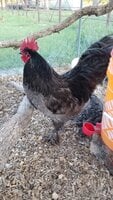noconachickenmama
Chirping
- Oct 14, 2019
- 39
- 79
- 64
So, my start in chickens began with a lot of wrong info...but I digress. I have a Langshan rooster, which as a day old chick I was told was a silkie. Then, as he grew, that was obviously wrong. Then I thought due to size, coloration, feathered legs, and the fact that another roo was pulling out his tail, that he was a Cochin. Even the hatchery said that's what he was. So I bought 8 cochin hens because I wanted to breed pure cochins. Now I find out he is a Langshan. I know they are related...does anyone know what I'll get if I breed a blue Langshan roo to various colors of Cochin hens? I have blue, black, white, silver laced gold laced and buff. Thinking of selling them and buying Langshans but they are hard to find and dont seem to come in many colors





